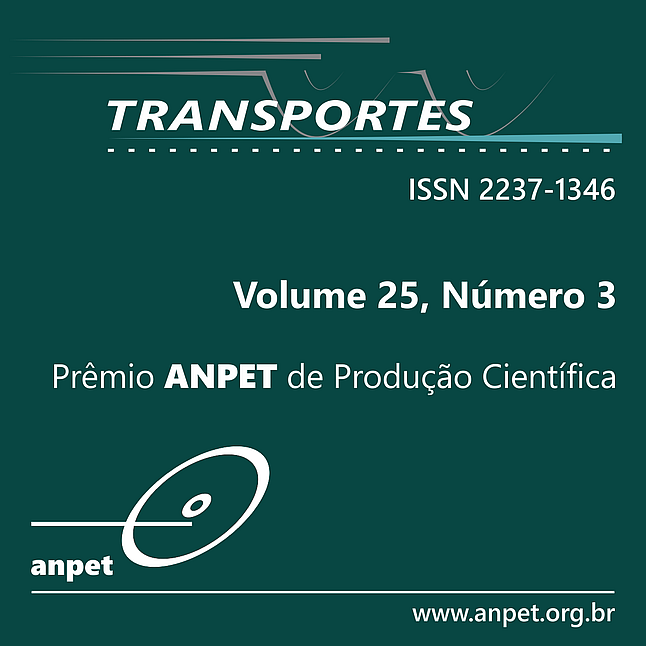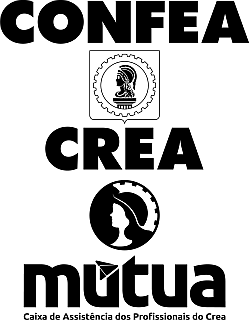Estimação da matriz origem-destino e da distribuição espacial da lotação em um sistema de transporte sobre trilhos a partir de dados de bilhetagem eletrônica
DOI:
https://doi.org/10.14295/transportes.v25i3.1347Palavras-chave:
Lotação, Transporte Público, Sistema Metroferroviário, Bilhetagem Eletrônica.Resumo
Este artigo apresenta os resultados de uma análise para estimar a lotação por trechos entre estações de um sistema metroferroviário, ao longo do dia, utilizando dados de bilhetagem eletrônica. É proposta uma adaptação da metodologia baseada no encadeamento de embarques no sistema de transportes, que infere o destino dos usuários, uma vez que não há bilhetagem nas estações de destino. Isso permitiu obter, de maneira rápida e eficiente, sem pesquisas de campo custosas, uma estimativa da matriz de origem-destino no sistema de transporte de passageiros sobre trilhos da Região Metropolitana de São Paulo (RMSP). A metodologia proposta também possibilitou obter o padrão espaço-temporal dos níveis de lotação para todas as linhas e sentidos da rede, assim como os volumes de transferências nas estações através da alocação da matriz ao longo de todo o período de operação e não apenas para os horários de pico, como usualmente feito a partir de pesquisas de campo com base em entrevistas com usuários.
Downloads
Referências
Alsger, A. A., M. Mesbah, L. L. Ferreira e H. Safi (2015) Use of Smart Card Fare Data to Estimate Public Transport Origin–Destination Matrix. Transportation Research Record: Journal of the Transportation Research Board, (2535), 88-96. DOI: 10.3141/2535-10
Barry, J., R. Newhouser, A. Rahbee e S. Sayeda (2002) Origin and destination estimation in New York City with automated fare system data. Transportation Research Record: Journal of the Transportation Research Board, (1817), 183-187. DOI: 10.3141/1817-24
Barry, J., R. Freimer e H. Slavin (2009) Use of entry-only automatic fare collection data to estimate linked transit trips in New York City. Transportation Research Record: Journal of the Transportation Research Board, (2112), 53-61. DOI: 10.3141/2112-07
Barbosa, B. (2016) Alívio na lotação de Metrô e CPTM deve ficar para 2017. UOL Notícias Cotidiano. Disponível em: <http://noticias.uol.com.br/cotidiano/ultimas-noticias/2016/01/11/alivio-na-lotacao-de-metro-e-cptm-deve-ficar-para-2017.htm>. Acesso em: 22 de junho de 2016.
Dijkstra, E. W. (1959). A note on two problems in connexion with graphs. Numerische mathematik, 1(1), 269-271. DOI: 10.1007/BF01386390
Feriancic, G., F. R. Celeiro e L. N. B. Silva (2015) Planejamento da Mobilidade com Big Data de Telefonia Móvel. 20º Congresso Brasileiro de Transporte e Trânsito, Santos.
Ferraz, A. C. P. e I.G.E. Torres. (2004) Transporte público urbano. RiMa Editora.
Google Transit (2016) Google Transit, documento de referência para desenvolvedores. Disponível em: <https://developers.google.com/transit/gtfs/reference>. Acesso em: 1 de julho de 2016.
Lin, M. e Hsu, W-J. (2014). Mining GPS data for mobility patterns: A survey. Pervasive and Mobile Computing, 12, p.1-16. DOI: 10.1016/j.pmcj.2013.06.005.
Kim, K. M., S. P. Hong, S. J. Ko e D. Kim (2015) Does crowding affect the path choice of metro passengers?. Transportation Research Part A: Policy and Practice, 77, 292-304. DOI: 10.1016/j.tra.2015.04.023
Metrô SP (2017). Site oficial do Metrô de São Paulo. http://www.metro.sp.gov.br/. Acesso em 13 de março de 2017.
Munizaga, M. A. e C. Palma (2012) Estimation of a disaggregate multimodal public transport Origin–Destination matrix from passive smartcard data from Santiago, Chile. Transportation Research Part C: Emerging Technologies, 24, 9-18. DOI: 10.1016/j.trc.2012.01.007
Nassir, N., A. Khani, S. Lee, H. Noh e M. Hickman (2011) Transit stop-level origin-destination estimation through use of transit schedule and automated data collection system. Transportation Research Record: Journal of the Transportation Research Board, (2263), 140-150. DOI: 10.3141/2263-16
Ortúzar, J. e L. G. Willumsen (1994) Modelling transport. New Jersey: Wiley. DOI: 10.1002/9781119993308
Pelletier, M. P., M. Trépanier e C. Morency (2011) Smart card data use in public transit: A literature review. Transportation Research Part C: Emerging Technologies, 19(4), 557-568. DOI: 10.1016/j.trc.2010.12.003
Rodrigues, M. A e Sorratini, J. A. A qualidade no transporte coletivo urbano. In: XXII Congresso de Pesquisa e Ensino em Transportes, 2008, Fortaleza, CE. Panorama Nacional da Pesquisa em Transportes 2008. XXII ANPET. Rio de Janeiro, p. 1081-1092.
Stasko, T., B. Levine e A. Reddy (2016) A Time-Expanded Network Model of Train-level Subway Ridership Flows Using Actual Train Movement Data at New York City Transit. In Transportation Research Board 95th Annual Meeting (No. 16-4090). DOI: 10.3141/2540-11
Tirachini, A., D. A. Hensher e J.M. Rose (2013) Crowding in public transport systems: effects on users, operation and implica-tions for the estimation of demand. Transportation research part A: policy and practice,53, 36-52. DOI: 10.1016/j.tra.2013.06.005
Wardman, M. (2004) Public transport values of time. Transport policy, 11(4), 363-377. DOI: 10.1016/j.tranpol.2004.05.001
Downloads
Publicado
Como Citar
Edição
Seção
Licença
Ao submeter um manuscrito para publicação neste periódico, todos os seus autores concordam, antecipada e irrestritamente, com os seguintes termos:
- Os autores mantém os direitos autorais e concedem à Transportes o direito de primeira publicação do manuscrito, sem nenhum ônus financeiro, e abrem mão de qualquer outra remuneração pela sua publicação pela ANPET.
- Ao ser publicado pela Transportes, o manuscrito fica automaticamente licenciado sob a Licença Creative Commons CC BY 4.0. Esta licença permite o seu compartilhamento com reconhecimento da autoria e da publicação inicial neste periódico.
- Os autores têm autorização para assumir contratos adicionais separadamente, para distribuição não exclusiva da versão do trabalho publicada neste periódico (por ex.: publicar em repositório institucional ou como capítulo de livro), com reconhecimento da publicação inicial na Transportes, desde que tal contrato não implique num endosso do conteúdo do manuscrito ou do novo veículo pela ANPET.
- Os autores têm permissão e são estimulados a publicar e distribuir seu manuscrito online (por ex.: em repositórios institucionais ou na sua página pessoal) depois de concluído o processo editorial. Como a Transportes é de acesso livre, os autores são estimulados a usar links para o DOI do artigo nesses casos.
- Os autores garantem ter obtido a devida autorização dos seus empregadores para a transferência dos direitos nos termos deste acordo, caso esses empregadores possuam algum direito autoral sobre o manuscrito. Além disso, os autores assumem toda e qualquer responsabilidade sobre possíveis infrações ao direito autoral desses empregadores, isentando a ANPET e a Transportes de toda e qualquer responsabilidade neste sentido.
- Os autores assumem toda responsabilidade sobre o conteúdo do manuscrito, incluindo as devidas e necessárias autorizações para divulgação de dados coletados e resultados obtidos, isentando a ANPET e a Transportes de toda e qualquer responsabilidade neste sentido.










